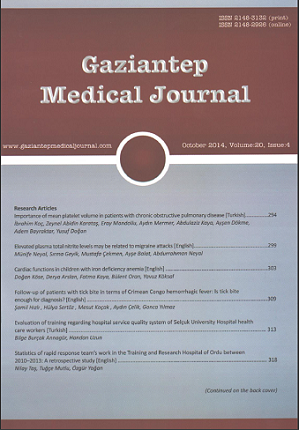Statistics of rapid response team’s work in the Training and Research Hospital of Ordu between 2010–2013: A retrospective study
Ordu Eğitim ve Araştırma Hastanesi mavi kod ekibi çalışma istatistikleri, 2010- 2013 yılları arası: Bir retrospektif çalışma
DOI:
https://doi.org/10.5455/GMJ-30-163057Keywords:
Basic life support, rapid response system, patient safetyAbstract
The rapid response system is an emergency intervention that is organized in order to guarantee basic life support in hospitals. In this study, we aimed to evaluate the patient profile and the results of intervention by retrospectively scanning the rapid response calls in Ordu University Training and Research Hospital between 01/10/2010 - 31/12/2013. Female patients comprised 44.9%, with 55.1% male patients, and mean age was 74.3 ± 12.6 years. The reasons for calls were as follows: 75.5% cardiac arrest, 16.9% respiratory arrest, 6% loss of consciousness or unidentified deterioration in clinical status, 1.4% respiratory distress due to epileptic convulsion and 0.2% allergic reactions. Inpatient services placed 68.8% of the calls. Day shift calls comprised 42.5%, with 57.5% made during the night time shift and mean arrival time was 1.51 ± 0.97 minutes. Cardiopulmonary resuscitation was applied to 81.6% of the patients, mechanical ventilator support without chest compressions was provided to 10% and medical support was provided to 8.4% of the patients. Mean intervention duration was 30.6 ± 16.2 minutes. The majority, 58.1%, of the interventions ended with exitus at the first intervention stage, 10.6% of all cases were transferred to the intensive care unit after the first intervention. Since cardiovascular events constitute the majority of the rapid response calls, it is important that, as well as the rapid response team, other hospital staff should be educated in basic life support and intervention should be applied as quickly as possible.
Metrics
References
Sağlık Hizmeti Kalitesinin Geliştirilmesi ve Değerlendirilmesine Dair Yönetmelik, 2013. Resmî Gazete, 6 Ağustos 2013, Sayı: 28730 (access date: June 2014).
Topçuoğlu M.A. Kardiyopulmoner arrestte serebral koruma. Yoğun Bakım Dergisi 2008; 8(1):22-43.
Eroglu SE, Onur O, Urgan O, Denizbasi A, Akoglu H. Blue code: Is it a real emergency? World J Emerg Med 2014; 5(1):20–23.
Madl C, Holzer M. Brain function after resuscitation from cardiac arrest. Curr Opin Crit Care 2004; 10:213–217.
Çertuğ A. Avrupa Resüsitasyon Konseyi 2010. Resüsitasyon kılavuzundaki temel değişiklikler. Anestezi Dergisi 2011; 19 (1): 1-14.
Murat E, Toprak S, Doğan BD. Mordoğan F. The code blue experiences: gains, problems and troubleshooting. Med- Science 2014; 3(1): 1002-12.
Çiçekci F, Atıcı SS. Mavi kod çağrısına bağlı kardiyopulmoner resüsitasyon uygulamaları sonuçlarının değerlendirilmesi. Genel Tıp Derg 2013; 23(3):70-6.
Koltka N, Çelik M, Yalman A, Süren M, Öztekin F. Kardiyopulmoner resusitasyonun başarısına etkisi olan faktörler. Türk Anest Rean Der Dergisi 2008; 36(6):366-372.
Bayramoglu A, Cakır GZ, Akoz A, Ozogul B, Aslan S. Saritemur M. Patient-staff safety applications: the evaluation of blue code reports. Eurasian J Med 2013; 45: 163-6.
Mehel D, Şen M, Sakarya Ö, Dinç S. Hasta ve çalışan güvenliğinde mavi kod uygulaması. ii. uluslararası sağlıkta performans ve kalite kongresi bildirileri kitabı. Sağlık Bakanlığı, Ankara. 2010; 772 (2): 614-6.
Nolan JP, Soar J, Zideman DA, Biarent D, Bossaert LL, Deakin C, et al. ERC guidelines writing group. European resuscitation council guidelines for resuscitation 2010 Section 1. Executive summary. Resuscitation 2010; 81(10):1219-76.
Bal A, Memiş R, Kılıç H, Çalış A, Yıldız A, Yılmaz H, et al. Mavi kod bildirimlerinin değerlendirilmesi. II. Uluslararası sağlıkta performans ve kalite kongresi bildirileri kitabı. Sağlık Bakanlığı, Ankara. 2010; 772 (2): 608-13.
Shin TG, Song HG, Sim MS, Song KJ. Improving survival rate of patients with in-hospital cardiac arrest: five years of experience in a single center in Korea. J Korean Med Sci 2012; 27: 146–152.
Downloads
Published
How to Cite
Issue
Section
License
Copyright (c) 2023 European Journal of Therapeutics

This work is licensed under a Creative Commons Attribution-NonCommercial 4.0 International License.
The content of this journal is licensed under a Creative Commons Attribution-NonCommercial 4.0 International License.


















